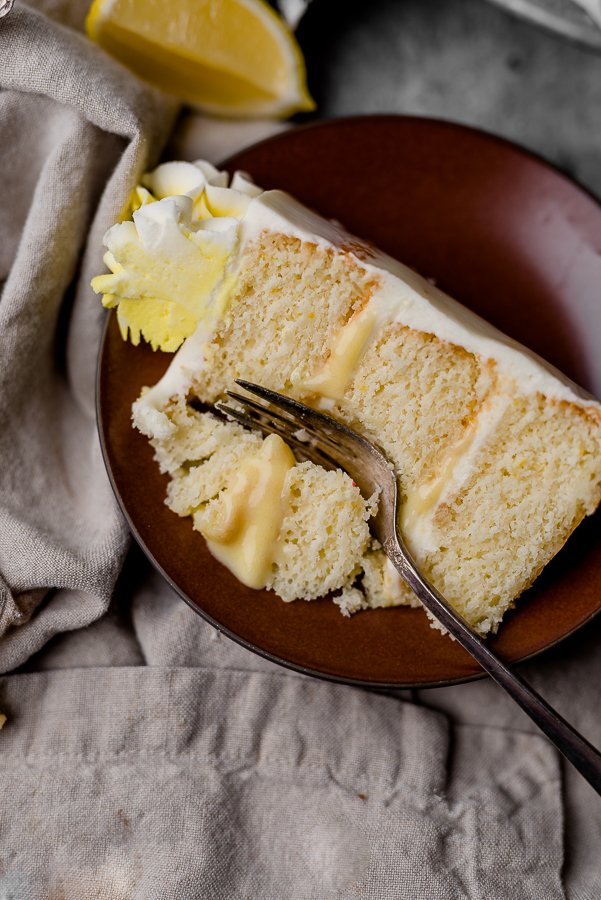Fresh Lemon Cake with Cream Cheese Icing
With both fresh squeezed lemon juice and lemon zest, this cake has the perfect zing of citrus flavor, all surrounded by the softest of cake crumbs.
Before I took to food photography and blogging, I ran a home baking business, and while I still take orders occasionally, I have almost entirely switched to this platform—I enjoy it so much more. This lemon cake was my most ordered cake, and although I have held it close to my heart, I’ve decided to slowly release my most popular desserts, starting with this citrus treat.
What Makes This Cake Special?
It is the combination of flavors and textures, that make this cake entirely delightful to eat. It has a nice citrus kick from fresh lemon juice and zest—no extracts here—and has a beautiful crumb, from my trusted technique of using a combination of cake flour and all-purpose flour. The mix of a lower protein flour, alternated with full fat buttermilk, yields an incredibly tender crumb.
Further, this cake is versatile, and can be made using a variety of fillings and flavors. Here, I am sharing it with a lemon curd filling and cream cheese icing, but raspberry, blackberry—any fruit really—would pair nicely with this cake.
What Is Citrus Season?
It’s a wonderful time of year because although it’s winter, a certain variety of lemon brings a bright spot of joy to bakers all around. This varietal is called a Meyer Lemon— it’s a cross between a lemon and a mandarin orange. Meyer Lemons are a bit sweeter than your traditional lemon, and I have also found them to be juicer, which is a positive when a recipe calls for fresh squeezed juice. The rind is thinner, and has more depth of flavor than a regular lemon peel—it adds its own unique flavor kick to recipes, and some individuals will only use Meyer lemons for certain dishes.
For this dessert, any lemon will suffice, but when Meyer Lemons are available, especially at a good price, they’re my first choice. Within the recipe, I provide a range of lemon juice needed for the cake. I did this for the sole reason that not all lemons are created equal, and further, everyone has a different threshold for citrus flavor. I personally like a full citrus kick, but occasionally I encounter a lemon that is particularly sour, and less juice is needed for full flavor.
Checking For Cake Doneness
At the bakery I worked a previously—a very popular and successful bakery in my area—we didn’t use timers or toothpicks in the traditional sense to check for cake doneness. Instead, we had large ovens, full of different cakes, cookies, brownies—you name it—and we checked for doneness with our hands. There was a timer used, but only to make sure we remembered to check the oven for the baked good that was closest to being finished. Let me tell you, this was super intimidating when I first started, and I definitely don’t expect this technique to be adopted in your home kitchen, but it’s something to think about. It felt empowering to understand when a bake was ready, using my senses, rather than blindly trusting a timer or tool.
With cake, one or two minutes too long, and the cake is overdone. One or two minutes pulled too early, and the cake is gooey inside. Ovens don’t always bake at the temperature indicated, and sometimes have a 10-15 degree (or more!) discrepancy—this can obviously have a negative impact on finished bake.
This is what challenges bakers, and what makes it so satisfying when a bake turns out perfectly. Using a toothpick is an effective tool, and don’t get me wrong, for certain recipes—like brownies—I always use a toothpick, but consider this a challenge to tune into your other senses. At home, I have melded both the techniques I learned at the bakery, with what is practical in my home kitchen. I use a timer as a base line, but after that threshold is reached, I look with my eyes and hands, using my senses as an indication when the cake is done. Tell tale signs include: a cake that starts to pull away from the sides of the pan, a cake that feels bouncy when touched, and further, If you pull a tiny bit of the cake from the middle, and it’s cooked—the cake is done.
Final Tip
Making a lemon curd filling is entirely optional, but does add a delicious element to the cake. Because of the lemon curd, I opted to keep the cream cheese icing plain. Lemon juice can certainly be added to the cream cheese icing, for further citrus flavor, but keep in mind this could make the frosting looser when decorting the cake.
You May Like These…























